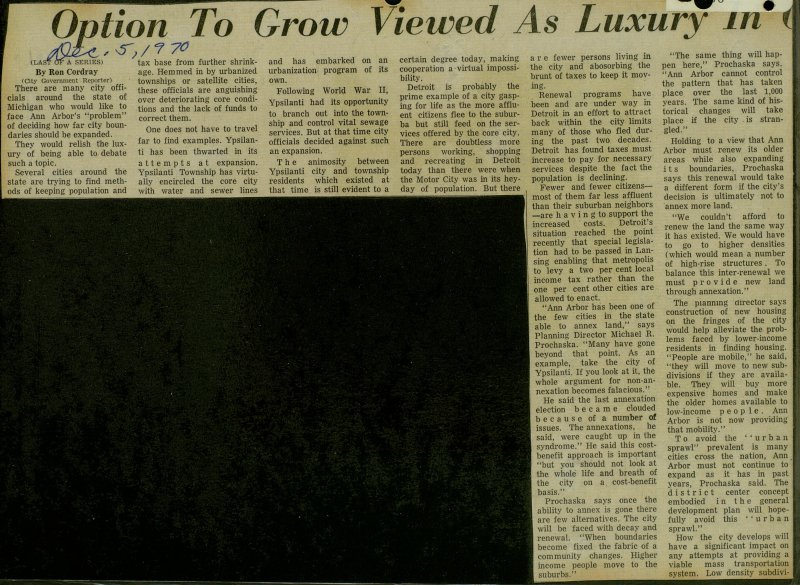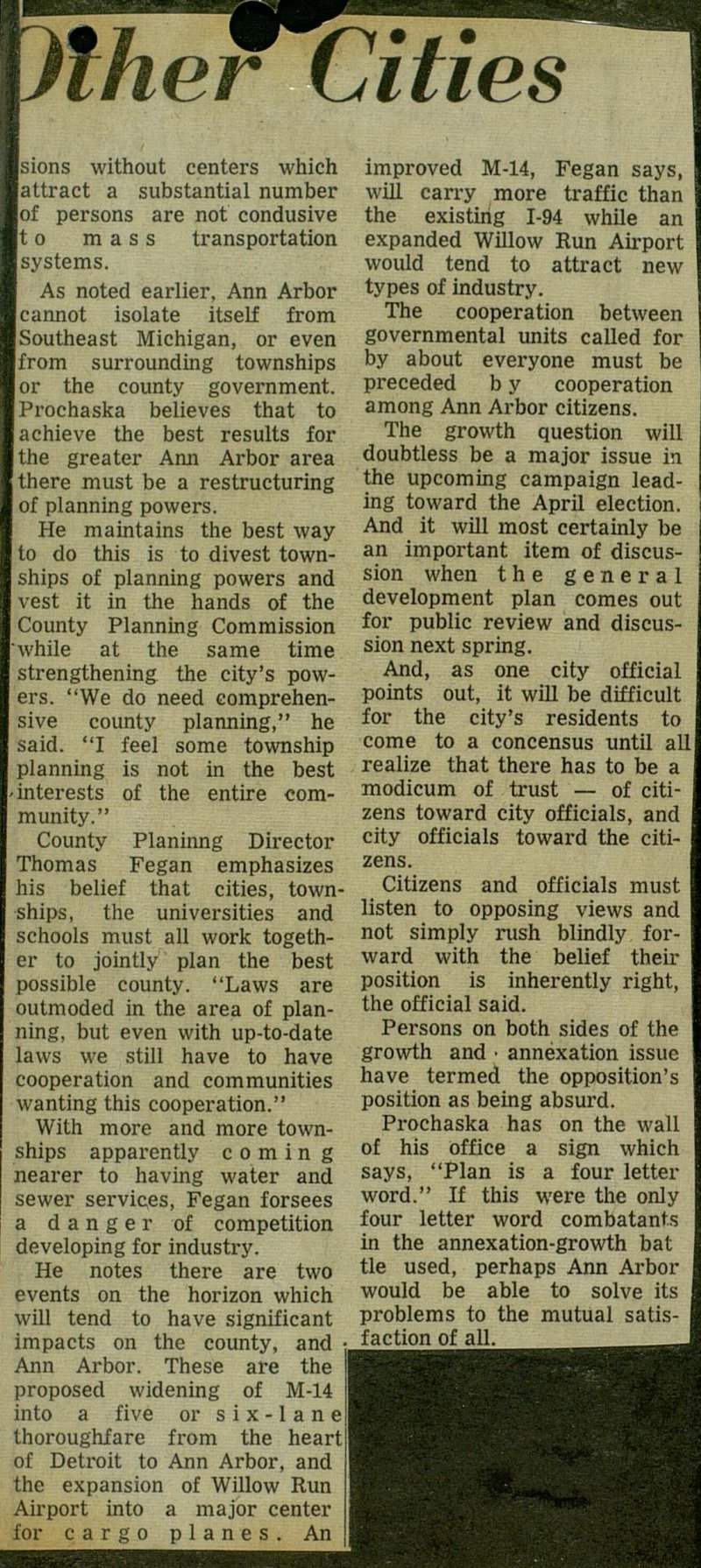Option To Grow Viewed As Luxury In Other Cities


(LAST OF A SERIES) There are many city officials around the state of Michigan who would like to face Ann Arbor's "problem" of deciding how far city boundaries should be expanded. They would relish the luxury of being able to debate such a topic. Several cities around the state are trying to find methods of keeping population and tax base from further shrinkage. Hemmed in by urbanized townships or satellite cities, these officials are anguishing over deteriorating core conditions and the lack of funds to correct them. One does not have to travel far to find examples. Ypsilanti has been thwarted in its attempts at expansión. Ypsilanti Township has virtually encircled the core city with water and sewer lines and has embarked on an urbanization program of its own. Following World War II, Ypsilanti had its opportunity to branch out into the township and control vital sewage services. But at that time city officials decided against such an expansión. The animosity between Ypsilanti city and township residents which existed at that time is still evident to a certain degree today, making cooperation a virtual impossibility. Detroit is probably the prime example of a city gasping for life as the more affluent citizens flee to the suburba but still feed on the services offered by the core city. There are doubtless more persons working, shopping and recreating in Detroit today than there were when the Motor City was in its heyday of population. But there are fewer persons living in the city and abosorbing the brunt of taxes to keep it moving. Renewal programs have been and are under way in Detroit in an effort to attract back within the city limits many of those who fled during the past two decades. Detroit has found taxes must increase to pay for necessary services despite the fact the population is declining. Fewer and fewer citizens- I most of them far less affluent than their suburban neighbors -are h a v i n g to support the increased costs. Detroit's situation reached the point recently that special legislation had to be passed in Lansing enabling that metropolis to levy a two per cent local income tax rather than the one per cent other cities are allowed to enact. "Ann Arbor has been one of the few cities in the state able to annex land," says Planning Director Michael R. Prochaska. "Many have gone beyond that point. As an example, take the city of Ypsilanti. If you look at it, the whole argument for non-annexation becomes falacious." He said the last annexation election b e c a m e clouded beca use of a number of issues. The annexations, he said, were caught up in the syndrome." He said this costbenefit approach is important "but you should not look at the whole life and breath of the city on a cost-benefit basis." Prochaska says once the ability to annex is gone there i are few alternatives. The city will be faced with decay and renewal. "When boundaries become fixed the fabric of a community changes. Higher income people move to the suburbs." "The same thing will happen here," Prochaska says. "Ann Arbor cannot control the pattern that has taken place over the last 1,000 years. The same kind of historical changes will take place if the city is strangled." Holding to a view that Ann Arbor must renew its older areas while also expanding its boundaries, Prochaska says this renewal would take a different form if the city's decisión is ultimately not to annex more land. "We couldn't afford to renew the land the same way it has existed. We would have to go to higher densities (which would mean a number of high-rise structures . To balance this inter-renewal we must p r o v i d e new land through annexation." The planning director says construction of new housing on the fringes of the city would help alleviate the problems faced by lower-income residents in finding housing. "People are mobile," he said, "they will move to new subdivisions if they are available. They will buy more expensive homes and make the older homes available to low-income p e o p Ie. Ann Arbor is not now providing that mobility." T o avoid the "urban sprawl" prevalent is many cities cross the nation, Ann Arbor must not continue to expand as it has in past years, Prochaska said. The district center concept embodied in the general development plan will hopefully avoid this ''urban sprawl." How the city develops will have a significant impact on any attempts at providing a viable mass transportation system. Low density Isions without centers which lattract a substantial number lof persons are not condusive t o m a s s transportation [systems. As noted earlier, Ann Arbor cannot isolate itself f rom Southeast Michigan, or even from surrounding townships or the county government. Prochaska believes that to achieve the best results for the greater Ann Arbor area there must be a restructuring of planning powers. He maintains the best way to do this is to divest townships of planning powers and vest it in the hands of the County Planning Commission while at the same time strengthening the city's powers. "We do need comprehensive county planning," he said. "I feel some township planning is not in the best interests of the entire community." County Planinng Director Thomas Fegan emphasizes his belief that cities, townships, the universities and schools must all work together to jointly plan the best possible county. "Laws are outmoded in the area of planning, but even with up-to-date laws we still have to have cooperation and communities wanting this cooperation." With more and more townships apparently c o m i n g nearer to having water and sewer services, Fegan forsees a d a n g e r of competition developing for industry. He notes there are two events on the horizon which will tend to have significant impacts on the county, and Ann Arbor. These are the proposed widening of M-14 into a five or s i x - 1 a n e thoroughiare from the heart of Detroit to Ann Arbor, and the expansión of Willow Run Airport into a major center for cargo planes. An improved M-14, Fegan says, will carry more traffic than the existing 1-94 while an expanded Willow Run Airport would tend to attract new types of industry. The cooperation between governmental units called for by about everyone must be preceded b y cooperation among Ann Arbor citizens. The growth question will doubtless be a major issue in the upcoming campaign leading toward the April election. And it will most certainly be an important item of discussion when the general development plan comes out for public review and discussion next spring. And, as one city official points out, it will be difficult for the city's residents to come to a concensus until all realize that there has to be a modicum of trust - of citizens toward city officials, and city officials toward the citizens. Citizens and officials must listen to opposing views and not simply rush blindly forward with the belief their position is inherently right, the official said. Persons on both sides of the growth and annéxation issue have termed the opposition's position as being absurd. Prochaska has on the wall of his office a sign which says, "Plan is a four letter word." If this were the only four letter word combatant.s in the annexation-growth bat tle used, perhaps Ann Arbor would be able to solve its problems to the mutual satisfaction of all. _